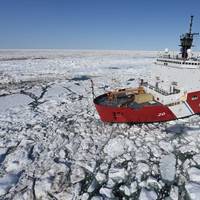Commandant Discusses Coast Guard’s Role in the Arctic

U.S. Coast Guard Commandant, Adm. Paul Zukunft presented at last week’s 6th Symposium on the Impacts of an Ice-Diminishing Arctic on Naval and Maritime Operations in Washington, DC. Summarizing Adm. In my role as the Commandant of the Coast Guard, I view the Coast Guard as the lead federal maritime agency when it comes to all things Arctic. By “all things Arctic,” I mean everything from safety of life at sea, to marine environmental protection, to fisheries enforcement and a whole host of Coast Guard missions. They all reside within one service, the United States Coast Guard.
Responder Immunity

Not long after specialized tank ships were developed, enabling the carriage of large quantities of oil and petroleum products, groundings, collisions, and other casualties started causing significant oil spills. In those early days, there was no financial incentive to clean up such spills. To the extent that there was a response, it was often by Good Samaritans, a term derived from a parable found in the Bible at Luke 10:25-37 about a stranger from Samaria who, with no thought of reward, came to the aid of an injured robbery victim in Judah.
EPA Statement: Use of Oil Dispersant on the Oil Spill
At the legislative hearing on the use of dispersants in the BP oil spill, Lisa P. Jackson, Administrator of the U.S. Chairman Mikulski, Ranking Member Shelby and Members of the Subcommittee, thank you for the opportunity to testify on the role of the U.S. Environmental Protection Agency (EPA) in the Deepwater Horizon BP oil spill response. My testimony today will provide you with an overview of EPA’s role and activities in the affected Gulf Coast region following the April 20, 2010 Deepwater Horizon mobile offshore drilling unit explosion and resulting oil spill as well as a summary of our primary environmental activities, including dispersant use, waste management, and beach cleanup.
EPA Releases Toxicity Testing Data for Eight Oil Dispersants
The US Environmental Protection Agency (EPA) released peer reviewed results from the first round of its own independent toxicity testing on eight oil dispersants. EPA conducted testing to ensure that decisions about ongoing dispersant use in the Gulf of Mexico continue to be grounded in the best available science. EPA’s results indicated that none of the eight dispersants tested, including the product in use in the Gulf, displayed biologically significant endocrine disrupting activity. While the dispersant products alone – not mixed with oil - have roughly the same impact on aquatic life, JD-2000 and Corexit 9500 were generally less toxic to small fish and JD-2000 and SAF-RON GOLD were least toxic to mysid shrimp.
Are They In Synch?
Recent spills in the Gulf of Mexico have demonstrated how tried and true oil spill recovery has combined with chemical dispersant technology to combat oil spills. On October 1, 1998, when a slick tracked to a crude oil pipeline leak off Louisiana's Gulf Coast was detected, the ready forces of oil responders were immediately activated. Along with a small armada of oil spill response vessels (OSRVs) hurrying to the site of the spill traced to a Chevron pipeline, a plane loaded with Corexit 9527 dispersant was deployed to shrink the growing oil slick estimated to be 37 kilometers long. By day two of the spill, dispersant operations had successfully shrunk the slick enabling OSRVs to contain the oil and finish the cleanup job.





